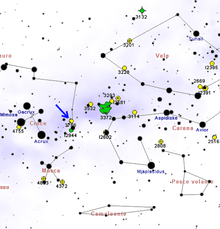NGC 3766
| NGC 3766 | |
|---|---|
|
NGC 3766 image taken with the MPG/ESO 1.2-metre telescope at the La Silla Observatory[1] Credit: ESO | |
| Observation data (J2000 epoch) | |
| Constellation | Centaurus |
| Right ascension | 11h 36.1m |
| Declination | −61° 37′ |
| Distance | 5.5 kly |
| Apparent magnitude (V) | 5.3 |
| Apparent dimensions (V) | 12.0′ |
| Physical characteristics | |
| Notable features | Easy to view via binoculars or telescope |
| Other designations |
NGC 3766, Lacaille III.7, Dunlop 289, Melotte 107, Collinder 248, C1133-613, Caldwell 97 |

NGC 3766 is an open star cluster in the southern constellation Centaurus. It is located in the vast star-forming region known as the Carina molecular cloud, and was discovered by Nicolas Louis de Lacaille during his astrometric survey in 1751–1752. At a distance of about 1745 pc,[2] the cluster subtends a diameter of about 12 minutes of arc.[3]
There are 137 listed stars, but many are likely non-members, with only 36 having accurate photometric data.[4] Total apparent magnitude of 5.3 and integrated spectral type of B1.7.[2] NGC 3766 is relatively young that is estimated as log (7.160) or 14.4 million years,[3] and approaching us at –14.8 km·s−1.[2] This cluster contains eleven Be stars, two red giants and four Ap stars.[4]
See also
References
- ↑ "New Kind of Variable Star Discovered". ESO Press Release. Retrieved 14 June 2013.
- 1 2 3 "SIMBAD Astronomical Dangc3766webdatabase". Results for NGC 3766. Retrieved 2013-06-13.
- 1 2 "WEBDA Astronomical Database". WEBDA Page for NGC 3766. Retrieved 2013-06-13.
- 1 2 "Webda Astronomical Database". WEBDA Page for NGC 3766a. Retrieved 2013-06-13.
External links
- NGC 3766 at SEDS
- Astrophotograph Link
- WEBDA Data on NGC 3766 by Lynga
- NGC 3766 on WikiSky: DSS2, SDSS, GALEX, IRAS, Hydrogen α, X-Ray, Astrophoto, Sky Map, Articles and images
Coordinates: ![]() 11h 36m 06s, −61° 37′ 00″
11h 36m 06s, −61° 37′ 00″
